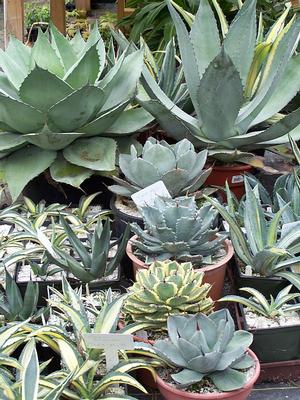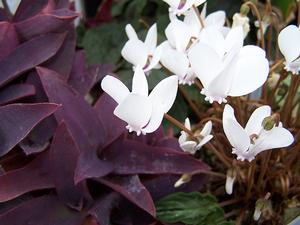
Agaves are beautiful. Not only are they armed with spines but their sap can also be poisonous.

Moses in the Cradle and Florist Cyclamen are poisonous
Beautiful Poison
There are a host of houseplants that are poison to cats and dogs. Some may cause discomfort or gastrointestinal issues, others can be deadly. Did you know that cocoa shells sometimes used as mulch in the garden if ingested by your pet dog may cause death? Chocolate, the treat that makes life worth living for many of us humans, is potentially toxic to your canine friend.
Many closely related plants will often share characteristics just as human families exhibit genetic traits. Poinsettias, a member of Euphobiaceae, produce a white milky sap called latex which is at least an irritant to pets and some people. All plants under the banner of Euphorbiaceae carry this milky sap, each containing various concentrations of latex. With anti-fungal and anti-bacterial properties the latex quickly fills a plant's wound protecting it from infection and rot, not unlike the clotting mechanisms found in the bloodstreams of mammals. But the latex also doubles as an evolved mechanism which protects the plant from becoming food. If leaves or bracts are eaten by pets or children stomach upset is likely to result. Some people will develop skin irritation by merely touching the sap. Contrary to popular myth, however, is that this sap is deadly. This is untrue unless it is ingested in virtually impossible doses.
Asparagus fern's proper moniker is Asparagus retrofractus. This lovely houseplant carries a toxic steroid called sapogenin especially found concentrated in the berry. Ingestion causes vomiting and diarrhea possibly accompanied with abdominal pain. Not deadly but annyoing is that skin inflammations or allergic dermatitis may erupt if sap or berry juice makes contact with skin.
Dumb Cane, Dieffenbachia picta contains raphides as does Heartleaf Philodendron, Philodendron scandens. These sharp, miniscule crystalline structures which puncture cell membranes in the mouth, throat, lips and tongue cause a stinging sensation that may last for weeks. Probably it is an evolved protective deterrent to browsing animals in the wild this attractive tropical is toxic to dogs and cats... people, too. Increased salivation, difficulty swallowing and vomiting are also side effects.
Elephant ear or caladium contains a chemical very similar to with symptomatic reaction like that of Dieffenbachia and: oral irritation, increased ptyalism or sialorrhea (salivation), difficulty swallowing, and vomiting.
Corn Plant, Dracaena fragrans, forms a toxic chemical compound called saponin. Appetite loss, depression increased salivation and / or vomiting with or without blood in the mix may result when ingested. Symptomatic cats may also display dilated pupils. You may know this commonly used office plant as cornstalk, dragon tree or ribbon plant. There are other common houseplants that are cousins of Corn Plant; Dracaena deremensis 'Janet Craig' and D. warneckii are two which harbor this family trait.
Common florist Cyclamen is toxic to dogs and cats. Ptyalism, vomiting and diarreha will likely occur if eaten. Ingesting a volume of the plant’s tubers, more likely a dog issue, will result in heart rhythm abnormalities and seizures possibly resulting in death.
Liliaceae is a huge family with many edibles in the ranks such as onions and yuccas. Some members embody a toxic side. Easter lilies are poisonous to cats. Lethargy, no appetite with vomiting are the first indication of trouble. Severe kidney failure resulting in death will follow soon after. Immediate treatment by your local veterinarian may be the only chance for recovery.
The Peace Lily also known as Mauna Loa is toxic to dogs and cats. Peace Lily is not a lily, rather it is Spathiphyllum wallisii, a member of the Araceae. The dead giveaway, pardon the dark pun, is its spathe flower. Containing calcium oxalate crystals ingestion of any part of the plant will likely irritate the tongue and lips, increase salivation, cause difficulty swallowing soon to be followed by vomiting. Calla lilies, too, are culprits. Silk Pothos, also a member of the family contains calcium oxalate crystals.
Jade plant is toxic to cats and dogs. The toxic property in Crassula argentea is yet unknown but symptoms of ingested plant parts may cause vomiting, depression, ataxia or in-coordination, and though unusual, a slowing heart rate or bradycardia may also occur.
Moses in the Cradle causes allergies and dermatitis. Cats are, apparently, spared difficulty with Tradescantia. Following the familial trend the poisonous trait of Tradescantia spathacea also extends to T. pallida, Wandering Jew.
Aloe vera which can be used effectively in topical application for burns is also, unfortunately, toxic to dogs and cats. Aloin is considered the toxic agent in this plant. Bitter tasting, yellowish aloin is found in most aloe species. Exhibiting a mucid texture it may cause vomiting and tinge urine red. I have been unable to ascertain if the reddish color might not be due to internal bleeding.
I'll soon pen a listing of safe, non-toxic houseplants as alternatives if testing toddlers and playful pets might be an issue in your home.
For more information about plant toxicity and a listing of non-toxic, safe alternatives please consider visiting the American Society for the Prevention of Cruelty to Animals (ASPCA) website at www.aspca.org or The Humane Society of the United States website at www.humanesociety.org.
penned by Wayne Paquette, October 2014